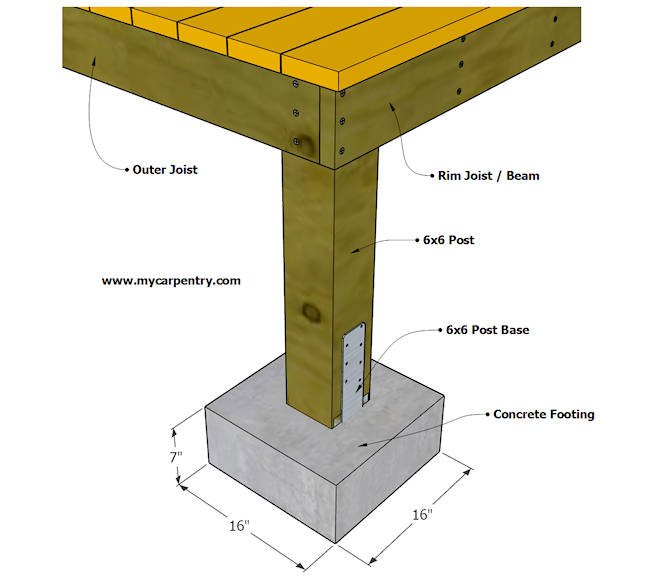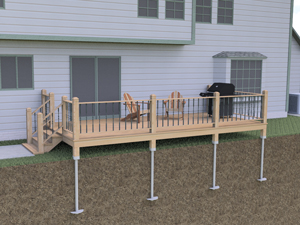Maximize the Life-span of Your Deck With Strong and reliable Footings
In order to completely maximize the life-span of your deck, it is essential to guarantee that it is built on solid and trustworthy grounds. These grounds develop the structure of your deck, supplying security and support, and are often the distinction between a deck that lasts for years and one that requires consistent repair work. In this conversation, we will discover the value of reliable footings, the different kinds of solid footing materials, appropriate installment methods, and how to maintain and inspect your deck's footings to protect against damages.
Value of Reliable Grounds
When it comes to making best use of the life-span of your deck,The importance of trustworthy grounds can not be overemphasized. The grounds act as the foundation whereupon the entire framework relaxes, offering stability and assistance. Without a solid footing, the deck is susceptible to shifting, sinking, and also collapse, which can substantially reduce its life expectancy and pose security threats.

Choosing the right kind of footing is likewise critical. Employing an expert to evaluate the soil, style the footings, and guarantee appropriate setup is highly advised.
Purchasing dependable footings might include additional expense and initiative upfront, yet it is a beneficial financial investment that will certainly contribute to the long-lasting durability and safety and security of your deck. By making sure a strong structure, you can appreciate your deck for years to come, understanding that it is constructed to hold up against the examination of time.
Kinds Of Strong Ground Products
To make sure the stability and longevity of your deck, it is vital to consider the numerous kinds of solid ground products offered. The selection of footing material is vital as it supplies the required assistance and security to stand up to the weight and tons of the deck structure.
One trusted and common material used for deck footings is concrete. Concrete grounds are durable and offer excellent security.
For areas with poor dirt conditions, such as expansive or loosened soils, a footing system that uses steel or composite piers might be preferred. Deck Footings. These piers are driven deep right into the ground to reach steady dirt layers, guaranteeing the security of the deck
In many cases, deck grounds can additionally be built making use of treated lumber. It is crucial to ensure that the lumber is properly treated to resist rot and decay caused by direct exposure to wetness and pests.
When choosing a footing product for your deck, it is essential to consider aspects such as dirt conditions, environment, and regional building ordinance. Consulting with a professional service provider or structural designer can aid establish one of the most appropriate footing product for your details deck project.
Proper Installation Strategies for Grounds
Thinking about the importance of guaranteeing stability and sturdiness for your deck, it is important to understand the appropriate installment methods for footings. The success of your deck project counts greatly on the honesty of its foundation, which is why adhering to the correct installation methods is important.
Most importantly, it is necessary to identify the appropriate dimension and depth of the grounds based on the style and tons demands of your deck. This information can be gotten from constructing codes or with examination with an architectural engineer. As a general rule, grounds should go to least 12 inches in diameter and extend below the frost line to avoid settling or moving.
As soon as the measurements are established, the following step is excavation. Digging the holes for the footings need to be done with accuracy, making certain they are deep enough and have a degree base. Deck Footings. This will provide a stable base for the footings
To further enhance the security of the footings, it is recommended to make use of a concrete mix with a stamina of at the very least 3,000 psi. This will ensure discover this info here the grounds can hold up against the weight and pressures applied by the deck.
During setup, it is important to maintain the grounds degree and straightened correctly. This can be achieved by utilizing a degree and string lines to assist the positioning of each footing.
Preserving and Checking Your Deck's Footings
Regular upkeep and detailed inspections are crucial for making certain the long-lasting stability and safety and security of your deck's footings. Over time, grounds can yield to tear and use, climate conditions, and soil movement, which can endanger their architectural stability. To optimize the life expectancy of your deck's grounds, it is critical to apply a regular upkeep regimen and conduct comprehensive evaluations.

In addition, it is important to examine footings for any type of indicators of damage or wear and tear. This includes monitoring for splits, splits, or collapsing concrete, in addition to any indications of movement or negotiation. Any problems must be addressed promptly to avoid more damages and ensure the security of the deck.
Furthermore, it is suggested to check the imp source surrounding dirt for any kind of signs of erosion or shifting. Dirt motion can influence the stability of the footings, so it is very important to attend to any kind of soil-related problems immediately.
Signs of Footing Damages and How to Address Them
Another indication of footing damages is collapsing or fracturing of the concrete footings. If you observe any fractures or deterioration in the footings, it is vital to have them checked and fixed by a specialist. Keep in mind, attending to ground damages promptly can aid ensure the lasting stability and safety of your deck.
Conclusion
In final thought, ensuring the reliability and stamina of footings is important for maximizing the lifespan of your deck. By utilizing solid footing materials and appropriately installing them, you can prevent damage and maintain the security of your deck.
These grounds develop the structure of your deck, offering security and support, and are usually the difference between a deck that lasts for years and one that calls anchor for constant repairs. In this discussion, we will discover the significance of reputable footings, the different types of strong footing materials, correct setup methods, and exactly how to preserve and check your deck's grounds to stop damage.Normal upkeep and thorough inspections are essential for guaranteeing the long-term stability and security of your deck's footings. Bear in mind, resolving ground damages promptly can help ensure the long-term stability and security of your deck.
By using solid footing products and correctly installing them, you can prevent damages and maintain the stability of your deck.
Comments on “Step-by-Step Deck Excellence: Making Sure Stability with Appropriately Installed Deck Footings”